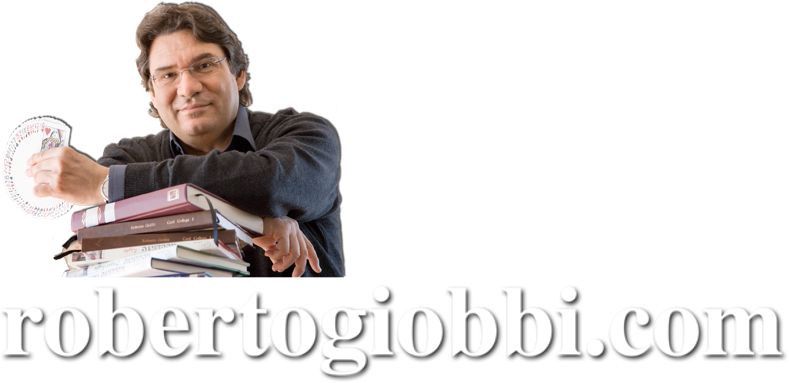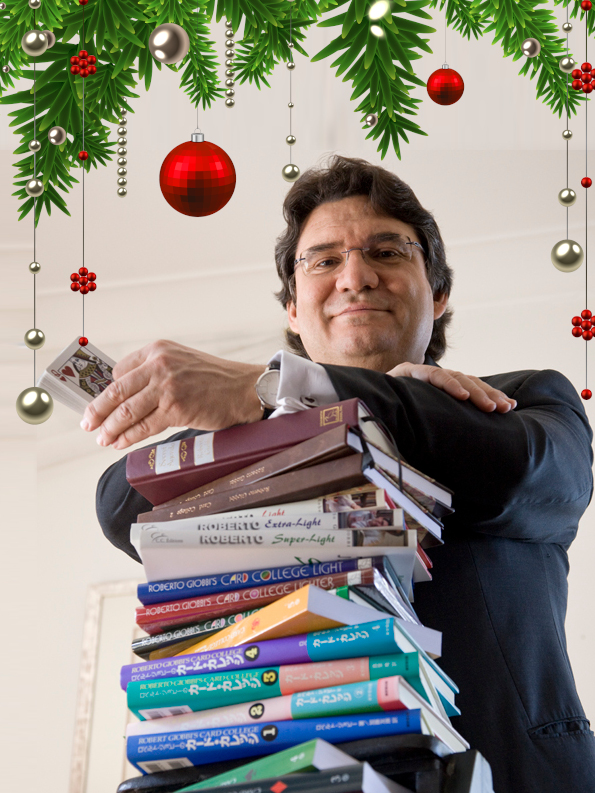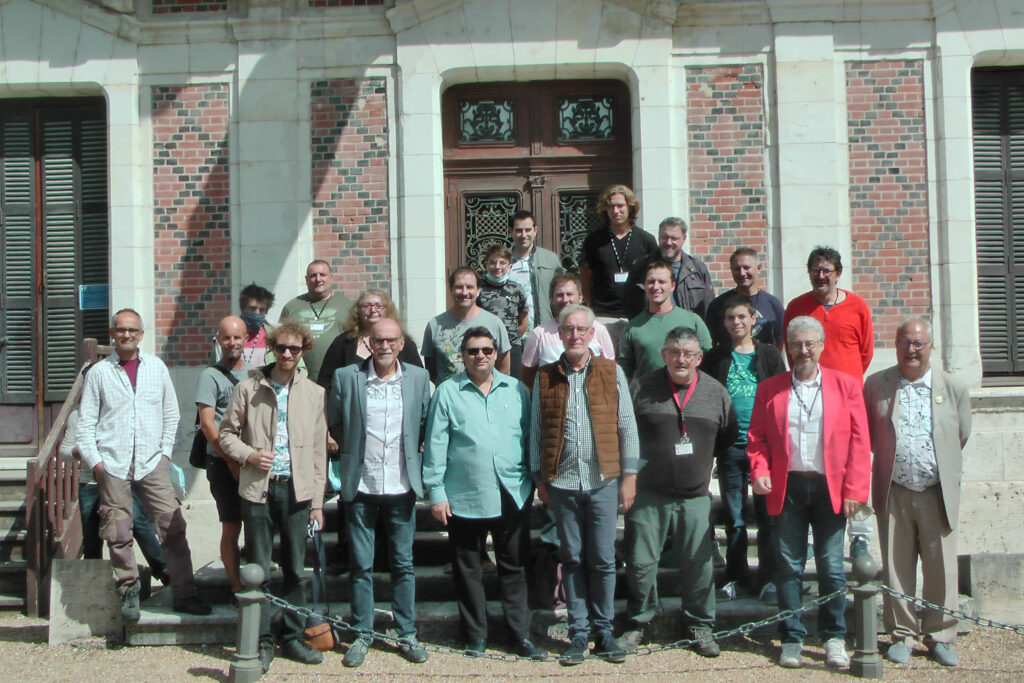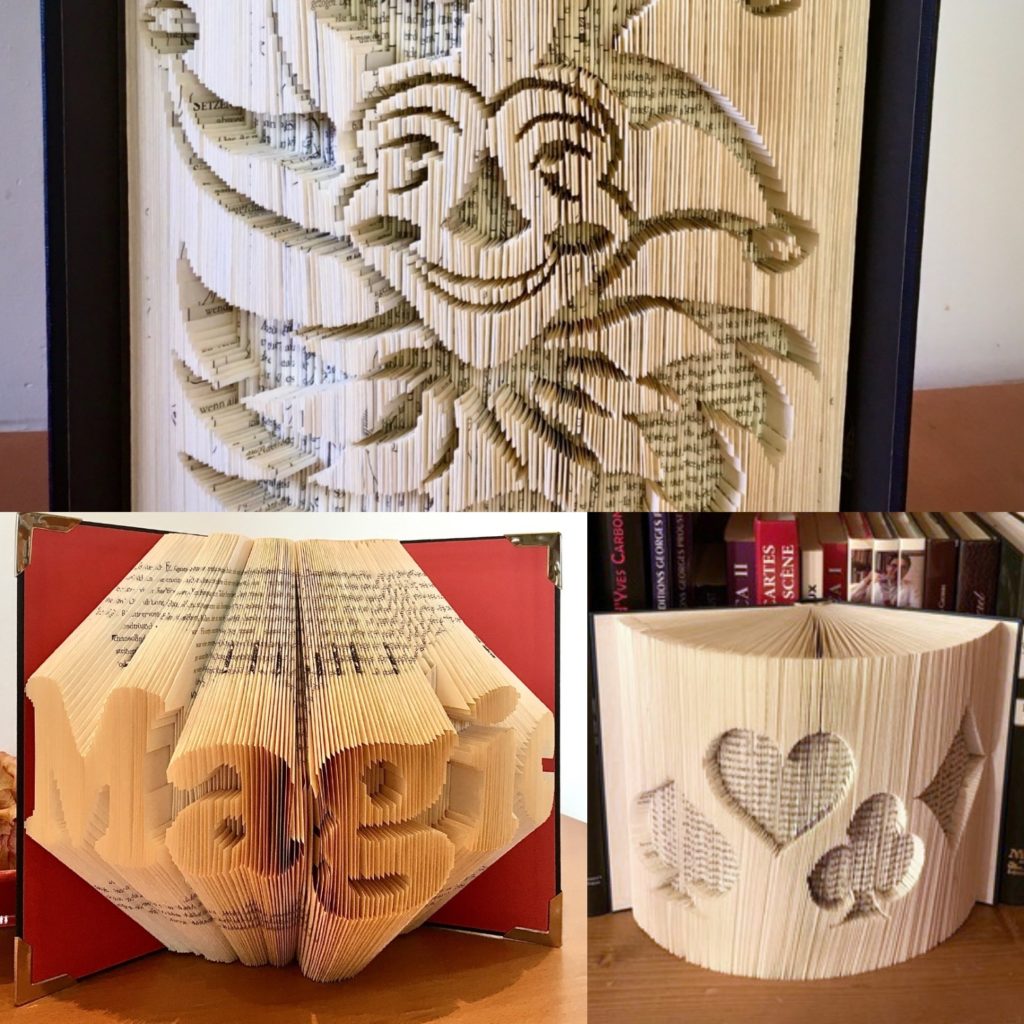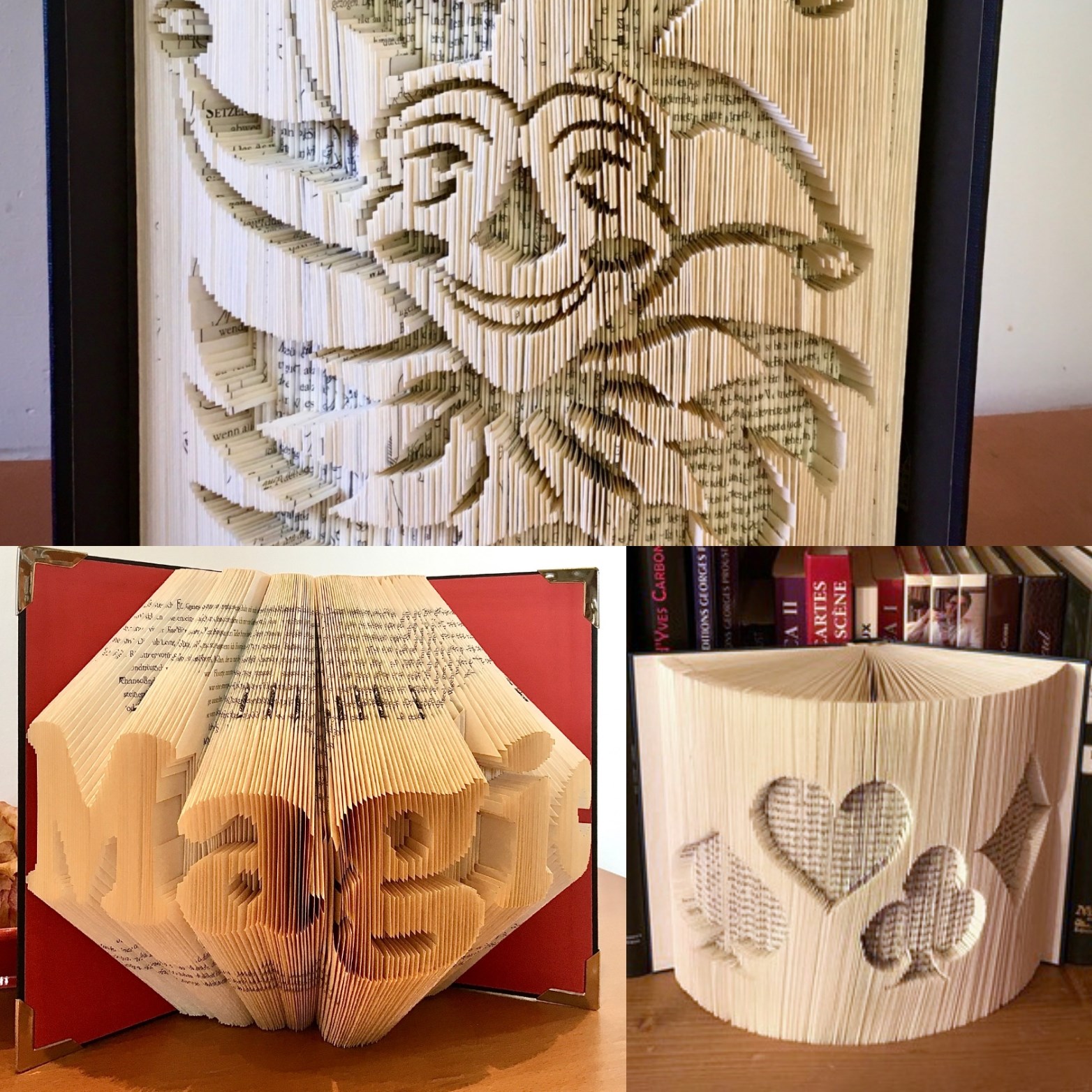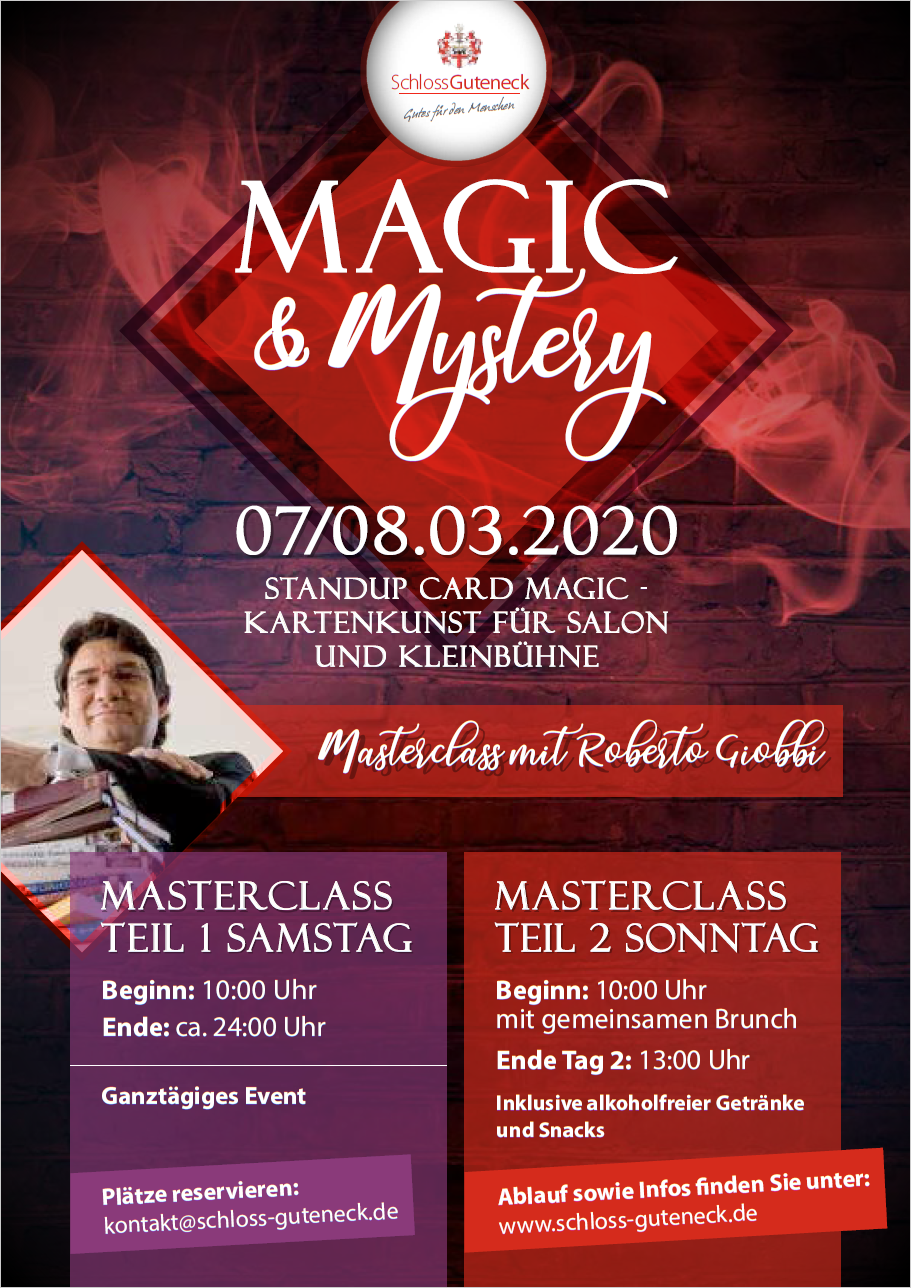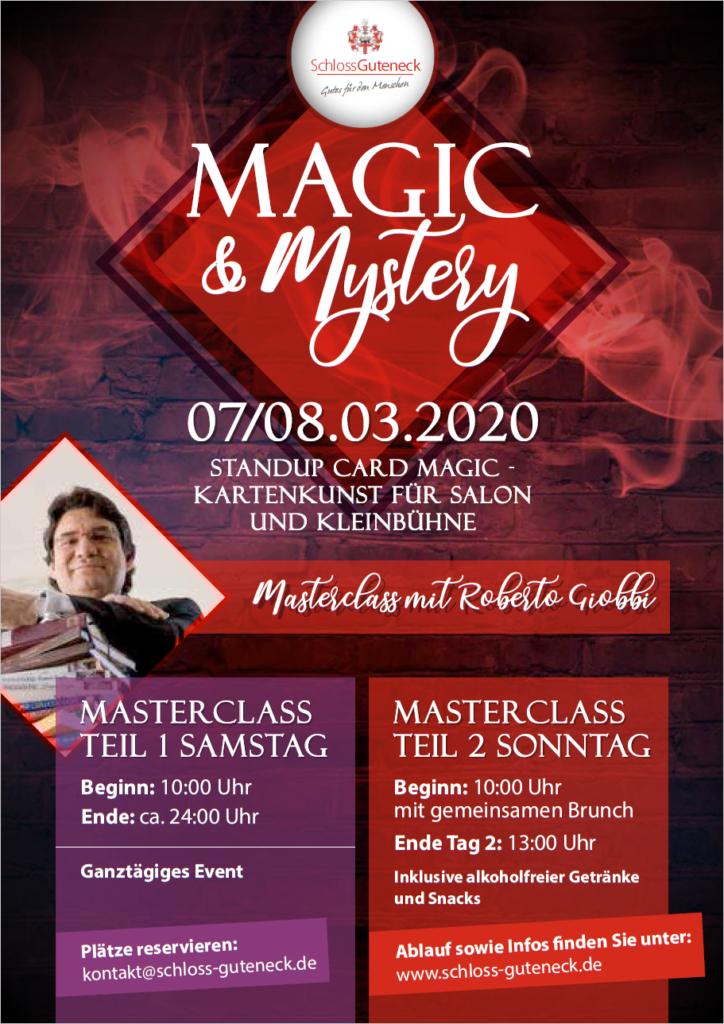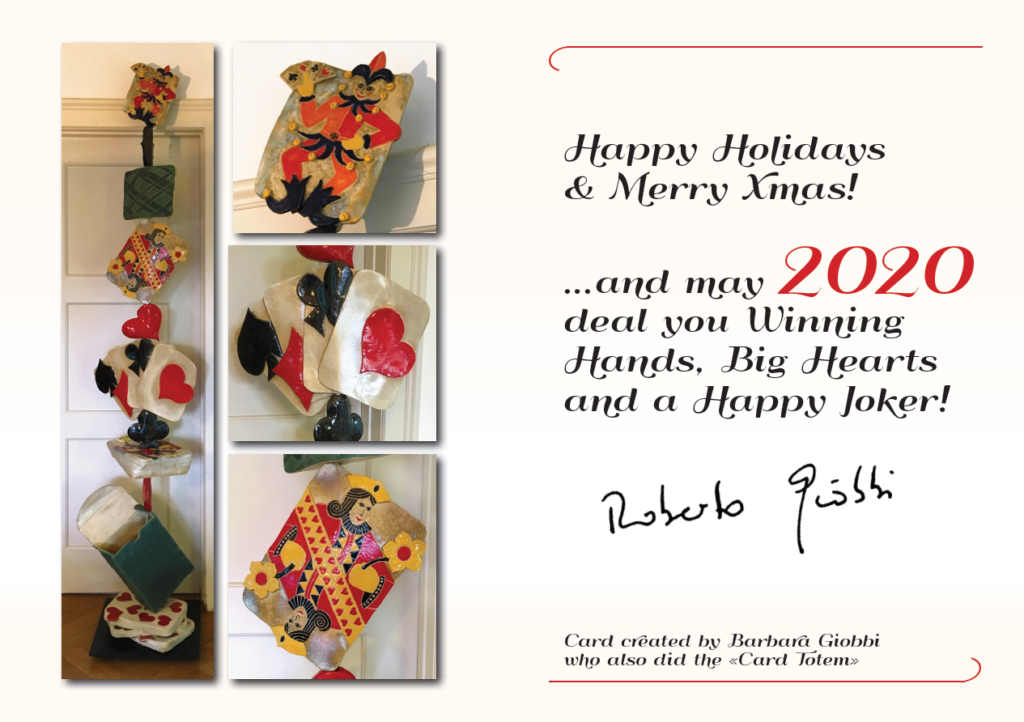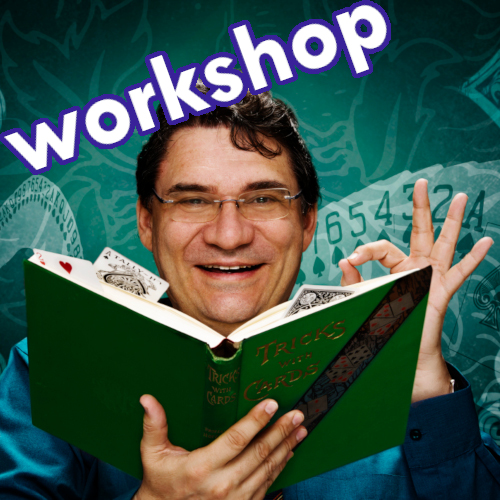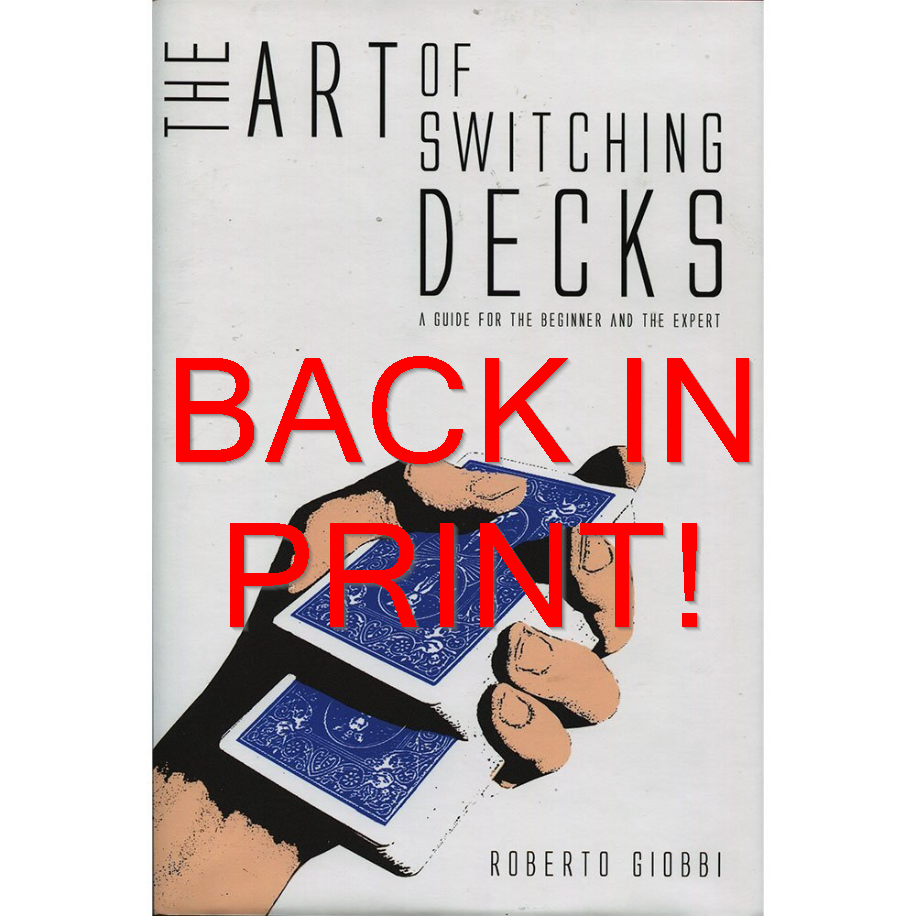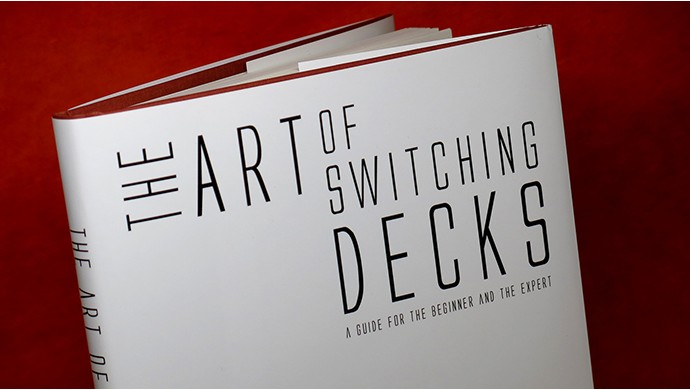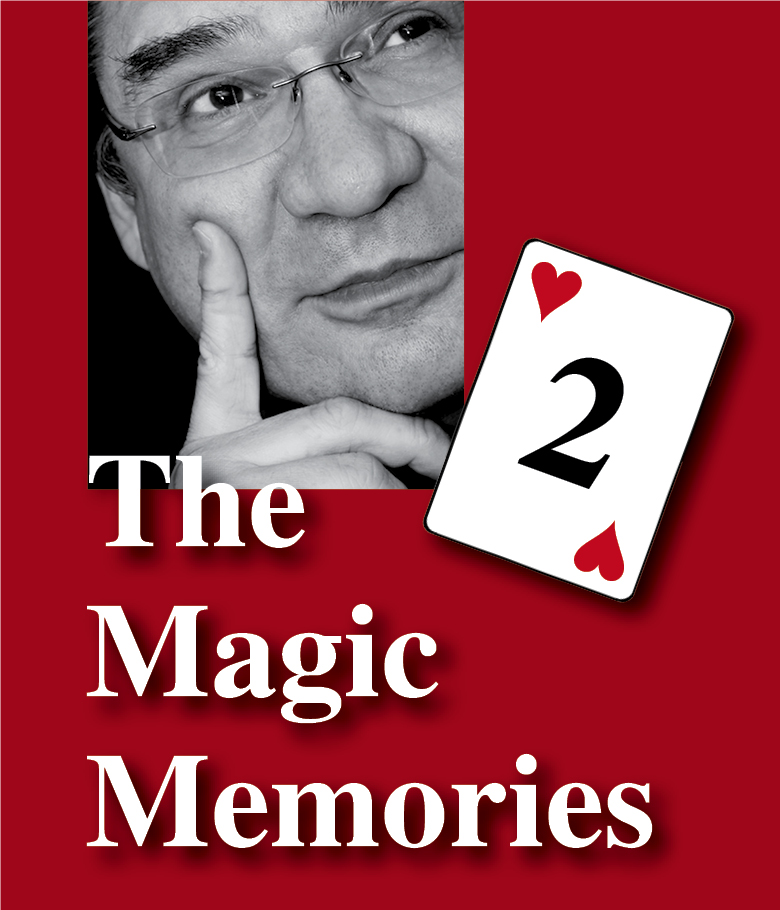
Dear all!
Plans were to be in Italy, France and the USA in these days, with shows, masterclass and a few lectures. But, alas, I’m home like most of you. At least I hope this finds you and your families healthy. We are fine, privileged to live in a house with a little garden, good weather, and two libraries (yes, two!) with over 6’000 books magical and otherwise, so there is not one second of boredom.
Therefore, here is an «Unexpected Secret Newsletter» (with nod to Marlo).
IMPORTANT NOTICE: Due to the extraordinary situation in the world and especially in Europe, the borders between Switzerland and Germany have been temporarily closed. I usually ship all book orders from Germany as their rates are much cheaper. I won’t be able to do so until they reopen the borders. This affects all books orders, not DVDs, as I can ship those as letters from Switzerland. And of course all downloads are fine. If you have any questions, please send me an email at giobbi@bluewin.ch and I’ll answer within 24 hours.
Subscribe to Secret Newsletter and browse the previous email at https://www.robertogiobbi.com/site/newsletter-archive/
On to this month’s topic:
Ask Roberto:
In my
Secret Letter #5 I discussed the Cull, and got some very positive feedback. Here is one that will be of interest to some readers. David McNay asked,
“Whilst my cull certainly needs some work, it is approaching functional, but I (and I’m sure others) struggle with the the correct stratagem if either the target card is very near the face (say positions 1-6) or if two (or more) target cards are very close together?”
I checked Card College 1 and Lesson 18 of Card College 1&2 – Personal Instruction (the video pendant to CC 1&2) which both treat the subject, and, shame on me, I did not discuss these problems. So here are a few solutions to the problem. I suggest you follow along with cards in hands, and you will understand and learn (a universal principle).
Problem 1: The target card to be culled is at or near the face of the deck.
Solutions to problem 1: You’re holding the deck face down in dealing position and plan to cull one or several cards. Turn the deck with the faces towards yourself, but in such a way that the spectators cannot see the face-card. This is just in case the target card happens to be on the face of the deck and you did not want them to see it. (Obviously this depends from the context of the trick, for context is always king.) If the order of the rest of the deck can be upset, casually turn the deck again face down as you converse with the audience, and then give it a brief Overhand Shuffle (see details of handling of how to shuffle the bottom card to the top artistically on p. 253 of Card College Volume 2). If the order of the remaining cards must be retained, use a Transfer Cut (chapter 6 in CC1) to achieve the same result.
If the target card is at position 2 from the face, you may either use the same approach as above, i.e. transfer cut it to the top, or try this, and you’ll be surprised how well it works: Start spreading the cards between the hands as you would for the regular Cull. As soon as the right hand has received the first two cards, the fingers of the right hand pull the 2nd card from the face to the right. Less than half an inch is necessary for the 3rd card and all those following to be fed between the 1st and 2nd card. Smoothly continue spreading cards. This move takes merely an instant, and if you look up and make a humorous or otherwise interesting remark (always relevant, of course, to the trick), the action will be invisibilized. But even if they watched, there would be little to see, since they usually don’t know what is coming and therefore what to look for. That’s called selective perception, and is one of our big friends in the toolbox of deception.
If the target card is at positions 3, 4, 5 etc. from the face, use the exact procedure as for the regular Cull. Try it with the card at position 3 from the faces and do it slowly until you understand and learn (this is another universal strategy of learning). You will notice that the first two cards, if kept spread by the right hand, will afford sufficient cover for the culling of the 3rd card, le alone for those following.
Problem 2: Several target cards are together or close to each other. This assumes that you want to cull e.g. four-of-a-kind, or even a complete suit.
Solution to problem 2: There are various cases that allow for various solutions.
Case1: You start spreading and arrive at two or even three target cards lying together. In this case the best approach is to close the spread, obtaining a break behind the target cards with the little finger, and then casually cut or shuffle them to the back. Now start anew and cull the remaining target card(s).
Case 2: You start spreading, cull one or several target cards individually, and then hit on a group of two or more target cards together. If these happen to be the last cards you want to cull, do as above, i.e. close the spread obtaining a break behind the target cards with the little finger, and then casually cut or shuffle them to the back.
Case 3: You start spreading, cull one or several target cards individually, and then hit on a group of two or more target cards together, but there are more cards after that group which you want to cull. Follow along, doing each action slowly at first, so your fingers understand: cull the first card of the group in the regular way as you extend the spread. When you collapse the spread again slightly, as you would to continue spreading, treat the next target card in exactly the same way as you did with the card you just culled, i.e. simply cull it, too. And then do the same with the next card. You’ll notice that this is as easy as pie, and the only “block” you had was a mental one, the fingers can do it. Once you’ve culled the target cards, continue the spread, and then cull any remaining cards, individually or together as you did up to here. Done.
I believe that you now have all the information necessary to solve any type of problem you may run into when using the Cull. And please keep in mind, “Before you practice, understand, but once you’ve understood, practice.”
You can send in your own question, and I’ll try to answer it at some point. You can always write to me at giobbi@bluewin.ch, but please do not be offended, if I do not answer, as I get many requests. But I always read you emails (unless I don’t receive them…). Meanwhile let me remind you that I have answered 52 questions in Ask Roberto, available both as an e-book and a printed book. I recommend the e-book, which is very comfortable to read on a tablet, one question a week, for a full year. Click here to see the table of content. Also remember that you can take coaching lessons via Skype (see below).
On Taking Notes & Store Them – Part 1
In
Secret Letter #5 I promised to write about how to take notes & store them. This is part of a larger talk on the subject of
how to study magic in general. A few days ago I gave a one-hour talk for the Club Magico Italiano (CMI) on their Facebook page, and if you understand Italian, you can watch it be clicking
HERE. It was on the subject of
how to read magic books and make the most of it, even if you have little time. However, even with one hour at my disposal, I had to realize that this is a
huge subject, worthy of a book, or better a full-day Masterclass or a lengthy video. Therefore I’ll have to split this into several parts, currently I’m planing four parts.
Reading Recommendations
Let’s start with a few reading recommendations. How to Read a Book – The Classic Guide to Intelligent Reading by Adler & Van Doren is just what the title promises, brilliant, but 425 pages long. For a quicker and easier read I have eight (!) essays in my (e)-book Ask Roberto that examine the subject from various points of view (the essays are: “4. How to Study”, “13. Creative Process”, “19. Effect Categories”, “23. Practice”, “25. Starting With Card Magic”, “37. “Navigate Info – How to Read Erdnase”, “39. Notebook & Journal”, “40. Repertoire Books”). Secret Agenda and Hidden Agenda have various days devoted to taxonomy and terminology, two important factors that show you how to tag the notes so you can easily find them again. There you will also find plenty of entries that deal with how to make intelligent notes and how to learn quickly and effectively. No more hints, go through the books again, you won’t regret it. Last but not least I’d like to mention Andi Gladwin’s Focusing on Magic, number 6 in the series of “Astonishing Essays” by Vanishing Inc.
Paper & Electronic Notes
You can take notes on paper or with an app. Important: one doesn’t exclude the other – use both! We will discuss electronic note-taking in one of the upcoming parts of this series. For now here a few suggestions for taking paper-notes.
Taking Notes on Paper
Although years ago I switched to mostly taking notes with Evernote app, I also have two dozen paper notebooks, some of them several hundred pages thick, which I wrote in the past 40 plus years, and which I’m still using. I only wear shirts with a breast pocket that always has a small pen in it and one of those mini-notebooks you find everywhere to fit. For short notes I prefer these to the smartphone; I then transfer the notes as soon as possible to a larger paper notebook or to Evernote. The photo below shows two such notebooks (ca. 6.5 x 10.5 cm).

It is important to take the note as clearly as possible, otherwise a week later you won’t know what it means. This is the reason why I try to transfer the note within 3 days to either a major paper notebook or to Evernote. Once a note has been transferred, I strike it through. Detail: I tear off the corner of the each page as it is completed, so I quickly find where to continue…
The notebooks themselves can be of different types. I like various sizes with DIN A5 preferred (4.1 x 5.8 inches). I use bound notebooks, such as the Moleskin notebooks, but also ring books and hanging fill-in to which i can quickly and easily throw any type of document (flyers, photocopies, instruction sheets etc.). If I was to start taking notes today, I would convert to the ADOC Coloredge notebook system, which I assume is obtainable worldwide. Tamariz uses them, and the advantage over a bound book is that you can add, remove and translocate single pages. I’d love to do a Card College Notebook System that combines paper and e-functions, if I knew how…
As to how to write a note down in a notebook, I recommend you have a look at the
Cornell Method, which is superb. Klick
HERE to see or download the Cornell Method of taking notes – I really urge you to do this.
I did not know about it for years, but from the beginning intuitively designed my notes in a similar way. The photo below shows a page from my very fist notebook, which I started at the FISM convention in Brussels in 1979, and the first note is Tamariz’s Perpendicular Control. I was one of the few to whom he had taught the then unpublished sleight personally, and I practiced it throughout the convention whenever nobody was watching…
As you can see, the notes are taken in a generous way, large writing, with enough space between notes. When you later look back over such a page, it will motivate you to reread your notes. If it was all written in small type and compressed, as I often see others take notes who probably want to save paper, you wouldn’t want to read it again.
Leave a generous border, and similar to the Cornell Method, write in a few words (here in red, which is a good idea) what the note is about. When later leafing through the notebook, you can quickly find an entry if you know what you are looking for. Notice the page number at the end of the page, which you’ll need to put in by hand, a nice Zen-type exercise, and very important. About a dozen pages before you reach the end of the notebook, start a table of contents. Here’s where you can combine the paper notebook with electronic features: create the Table of Contents as a PDF, which can then be searched or automatically arranged in alphabetical order! Creating the table of contents has another big advantage: it will force you to go over each note once again and reevaluate it. Maybe you have a new insight, which you then note on the margin, or as suggested in the Cornell Method, in the space left empty on the bottom of the page (this is a very useful idea!).
OK, that’s it for today, folks. Your assignment (I’m a born teacher, aren’t I 🙂 for our next meeting is to start a notebook, if you do not already have one, and begin to take notes as explained. If you already have one, you might still be able to incorporate one or two of the ideas exposed and make better notes from now on. In part 2 of this series we will discuss how to use the notebook to make notes when watching a video. Part 3 will be about how to read and annotate a written document (book, magazine, lecture note etc.). And in part 4 I shall try to show you how I use Evernote.
What Did Not Go Into The Agendas
This is a new heading in this and future
Secret Letters and contains, as the title suggests, items that did fit neither into
Secret Agenda, nor
Hidden Agenda nor
Secret Twitter, for various reasons, but which I believe will be of interest to some of you. If I write enough
Secret Letters, and you collect them, you’ll have a fourth
Agenda for free! I was inspired by reading a quote from Georg Christoph Lichtenberg (1742 – 1799), which translates approximately like this, “Of some important authors I would rather be interested to know what they discarded than what they chose.” I apologize for the implicit immodesty, but here we go:
Squirmy Spell
In some effects a spectator is asked to name a card, and it will then be necessary to immediately know the number of letters to spell it. How do you do this? The best way is to know them by heart, of course, by making a list, which I suggest you do anyway and store among your notes. But here is a quick fix: repeat the name of the card, as if to make sure you understood it correctly, and also to tell the rest of the audience who might not have heard it. As you do so, use your fingers under the table to count the letters. I do this by closing my hands into fists, and then stretching out one finger after the other for each letter, starting with the right thumb. If the count goes over “ten”, which it mostly does, I come back to the right hand, which I closed, and then restart stretching out fingers. Easy, quick and safe. (I got this from Daryl’s video series Encyclopedia of Card Sleights.)
Orimotos by Barbara
Orimoto is a kind of book-origami where you cut each page of a book and fold it in a particular way so that a message or design will be visible relief-style. It is quite laborious, as each page is treated differently and by hand. Since a picture says more than a thousand words, here are a few of Barbara’s magical subjects, made with waste copies of the German edition of Card College (nothing less!).
In case you would like to buy one, answer this email, and we’ll give you details. You should budget between $ 80 and $ 160, depending on the complexity of the design (e.g. the “MAGIC” Orimoto is much easier to do than the “JOKER” Orimoto) plus shipping. You can ask for your own design, and we’ll let you know if it doable and what it would cost.
Back Issues of Secret Newsletter
Many have asked where they could access past
Secret Newsletters, as in each of them I treat several important topics and answer your questions. My Webmaster Andrea Pancotti, whom I would like to publicly thank at this point for all his help and advice, has set-up a new menu item simply called “Newsletter”, which you can access over the menu bar of the webshop, or simply
CLICK HERE. There you can download past
Secret Letters as practical PDFs.
Interview With Roberto Giobbi
If you’re interested to know a little more about myself and some of my thoughts on various issues of magic, here is a lengthy interview conducted by
BoardGameGeek reviewer EndersGame. I suggest you use “Pocket” app or “Evernote Web Clipper” to download it and read it offline. In such cases I convert the text into a
PDF, which I can read anytime on the plane or in the train, and also
annotate it or
extract relevant text passage (this is already a preview on the subject of “How to Take Notes”, which we’ll deal with in an upcoming
Secret Letter). To get to the interview
CLICK HERE.
Wer deutsch versteht, findet hier den zweiten Teil eines Interviews, das Semjon Sidanov mit mir geführt hat und das etlichen Usern seines YouTube-Kanals gut gefallen hat. HIER GEHT’S ZUM INTERVIEW.
Want a book signed to you personally?
When you order a book or DVD from me, you can ask it to be signed to your name, but you must mention this in the “comment” field of the order form, please. I do not automatically sign, as I never know who eventually gets the book/DVD.
Personal Coaching Live or via Skype
If you are interested to receive personal advice on anything related to your magic, or if you merely want to ask me questions or chat with me, you can take personal coaching lessons at my studio in Muttenz, Switzerland, or via FaceTime/Skype. It is $ 150 for 75 minutes, so, cheaper than a pimp, and I would bet with better results 🙂 For details contact me HERE.
TCC Chop Cup
TCC is my publisher in China, and we have already seven books together out there, which I’m told are quite successful. They will also soon release the Card College Playing Cards I’ve mentioned before through Kickstarter, and I’ll let you know as soon as this happens. Meanwhile, if you are interested to obtain a fine hand-made leather Chop Cup at an amazing price, klick here. When I did a one-month-tour in China in OCT of last year, I had a chance to visit their premises in Shenzhen and can assure you that they create and produce some of the finest props in the industry, and their business behavior and ethics are top-notch.
The Missing Link
Under this heading I propose one unusual web-link, which you’ll hopefully find inspiring, and if nothing else simply amusing. This one is about “Anamorphic Art Installations” by Michael Murphy, and it is a perfect metaphor for reframing, i.e. experiencing something in a completely different way if we look at it and approach it from a different angle: https://www.youtube.com/watch?v=SKfpYVK_r0E
With a mini-projector and an empty wall or similar, you can show the clip, and then use it as a Prologue and presentational idea for a trick. This is just one of the many practical suggestions you’ll find in the Agenda books; for details on this particular idea see the entry “Film Clip Prologue” for February 20 in my Hidden Agenda – to a performing magician, this alone is worth many times the price of the book.
Let your friends know, please
If you believe that this newsletter (and those before) could be of interest to your friends, please forward this Secret Letter to them. To get it directly, they simply have to want to sign up for it HERE, where they can also download previous issues.
More on the next occasion, there are several questions of yours waiting to be answered – take care of yourself AND the others!

Roberto Giobbi


